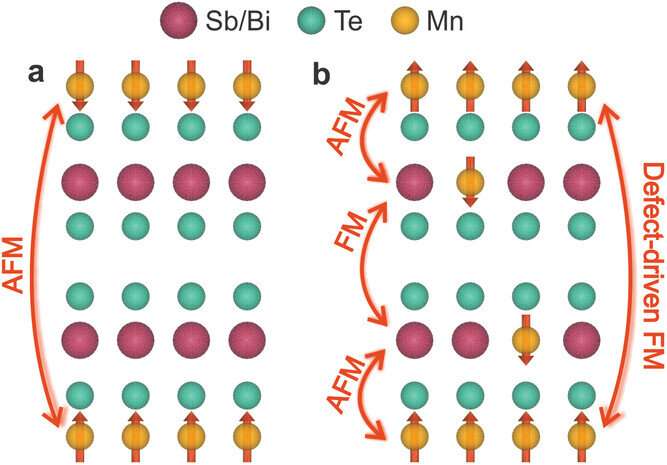This article has been reviewed according to Science X's editorial process and policies. Editors have highlighted the following attributes while ensuring the content's credibility:
fact-checked
peer-reviewed publication
trusted source
proofread
Scientists make a surprising discovery about magnetic defects in topological insulators

Scientists from the Department of Energy's Ames National Laboratory made an intriguing discovery while conducting experiments to characterize magnetism in a material known as a dilute magnetic topological insulator where magnetic defects are introduced. Despite this material's ferromagnetism, the team discovered strong antiferromagnetic interactions between some pairs of magnetic defects that play a key role in several families of magnetic topological insulators.
Topological insulators (TIs) as their name indicates, are insulators. However, because of their unique electronic band structure, they conduct electricity on the surface under the right conditions. By introducing magnetism, TIs can transmit electrical currents from one point to another without any heat generation or energy loss. This quality means that they have the potential to reduce future energy footprints for computing and electricity transmission.
According to Rob McQueeney, a scientist from Ames Lab and a member of the research team, "Finding topological insulators is not so easy. You have to find this unique situation where the electronic bands are knotted up." He further explained that applying a magnetic field to a TI turns the surface into a unique two-dimensional insulator, while the very edges of the surface remain metallic.
An important goal is to obtain a ferromagnetic TI. Ferromagnetism is when all of the magnetic moments in the material spontaneously align in the same direction. However, the team also discovered that TIs are susceptible to antiferromagnetic interactions when defects are introduced. Antiferromagnetism is when some of the ions spontaneously align with neighboring ions. The opposing magnetic forces decrease the overall magnetism of the material.
There are two ways that scientists introduce magnetism into a TI. The first is to introduce dilute amounts of magnetic ions, such as manganese-doped bismuth telluride or antimony telluride. The second is to create an intrinsic magnetic TI by inserting a layer of magnetic ions into the material, such as manganese-bismuth-tellurium (MnBi2Te4) and manganese-antimony-tellurium (MnSb2Te4).
Since the intrinsic magnetic TIs have a full layer of magnetic ions, ideally the magnetism is not randomly distributed the way it is in the first method.
For this project, the team focused on dilute magnetic TIs, which have randomly distributed magnetic defects. "We wanted to understand the magnetic interactions at the most fundamental level. We were doping our sample using small amounts of magnetic ions to try to understand how the magnetic interactions occur," said Farhan Islam, an Iowa State University graduate student and team member. "So basically, we're trying to understand how microscopic interactions affect the overall magnetism of the system."
To conduct their research, the team used a specialized method called neutron scattering. This method involves passing a beam of neutrons (sub-atomic particles with a neutral charge) through a sample of material. Data is collected by noting where and when the neutrons that scattered from the sample hit a detector.
This type of research can only be done a few places in the world. Neutron scattering for this project was conducted at the Spallation Neutron Source, a Department of Energy Office of Science User Facility operated by the Oak Ridge National Laboratory.
One challenge with neutron scattering is its weak signal. The team had concerns about studying dilute magnetism, because of the small overall number of magnetic ions. "I was very skeptical that we would see anything at all," said McQueeney. "But we did. Actually, what we saw was pretty straightforward to observe, which was surprising."
The team discovered that despite the overall ferromagnetism of manganese doped antimony telluride (Sb1.94Mn0.06Te3), some isolated pairs of magnetic defects are coupled antiferromagnetically with opposite moment directions. Other magnetic pairs, especially those in different blocks of the layered structure, are ferromagnetically coupled with parallel moments. The competing magnetic forces decrease the overall magnetism of the material.
"The intrinsic magnetic TIs actually have defects in it," Islam explained. "So for example, manganese can actually go into the sites of antimony where they're not supposed to be and the way the manganese is going into those sites is random."
This random manganese site-mixing creates magnetic defects in the intrinsic magnetic TIs. The team found that the same interactions between defects in the dilute materials also occur in the intrinsic materials (i.e. MnSb2Te4). The magnetic ground state of the intrinsic magnetic TIs can be either ferromagnetic or antiferromagnetic, and the team now understands how magnetic defects control this behavior.
"We determined the interactions between defects in the dilute case and realized that these interactions are transferable to the intrinsic case," said McQueeney. "By doing so, we conclude that defects control the magnetic order for both families."
The study is published in the journal Advanced Materials.
More information: Farhan Islam et al, Role of Magnetic Defects in Tuning Ground States of Magnetic Topological Insulators, Advanced Materials (2023). DOI: 10.1002/adma.202209951
Journal information: Advanced Materials
Provided by Ames National Laboratory





















